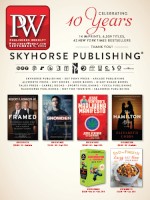Following the success of the book ¿Quién se ha llevado mi queso? (Who Moved My Cheese?) in 2001, Urano Publishing, a midsize publisher from Spain, opened a small office with a warehouse in Miami. However, the cost of running a business on only a few titles, in a market that had not fully developed, became quite challenging. Urano owner Joaquín Sabaté decided that in order to make the U.S. operation viable he would have to partner with other publishers. Soon after, Editorial Tusquets joined Urano (Tusquets would leave the partnership in 2010 following its purchase by Grupo Planeta).
By 2004, Spanish publishers Ediciones Obelisco, Editorial Sirio, Roca Editorial, and Ediciones B had joined Urano in Miami. Five years later the five publishing companies decided to form Spanish Publishers, a consortium that allows them to share in the cost of doing business while giving them the opportunity to expand in the U.S. and Puerto Rico. In the past couple of years, the consortium has taken on distribution for three additional Spanish publishers: Anagrama, Edaf, and Salamandra.
PW spoke with Lucia Laratelli, president of Spanish Publishers. Laratelli has been working with the companies that created Spanish Publishers since 2002, and prior to that she was with Santillana U.S.A., a Spanish publisher also based in Miami.
Since Spanish Publishers’ model is unique, could you please explain how it works?
The model has worked beautifully for publishers. It allows publishers to release their titles in the U.S. at the same time as they are released in Spain and Latin America. Readers no longer have to wait months for a distributor to obtain the books and ship them to the U.S. It also allows the publishers to select the titles they would like to sell in the U.S., versus the distributor choosing a handful of titles from each publisher.
How often do you release new titles?
Every month we receive a shipment from Spain that includes the titles of all of the publishers. This allows Spanish Publishers to provide new titles on a regular basis and keep prices competitive with books published in the U.S.
How so?
The shipment in consolidated in Spain, so we are able to keep shipping costs down. This is also why we are currently only working with publishers from Spain. We have been approached by publishers in Mexico, but in order for this model to work, we would have to have several publishers interested so we can do one monthly shipment from Mexico. We are currently in conversation with a couple of publishers from Mexico. Soon we hope to have some news to share with you.
You offer books from different publishers—what are some of your bestselling titles or authors?
Some of our bestselling authors are those that are bestsellers in English, such as Nicholas Sparks, David Baldacci, James Patterson, Christine Feehan, and Brian Weiss. Of course the Harry Potter series as well as Percy Jackson and Hush Hush sell well. We have over 10,000 titles and bring in about 20 to 30 new titles per month, in quantities that range from 200 to a few thousand copies of each title. We have something for everyone. And Who Moved My Cheese? in Spanish is still selling very well.
Do you sell directly to libraries or work primarily through distributors?
We don’t sell directly to libraries but do send them a weekly email on the latest titles as well as a quarterly printed catalogue. We have found that many librarians still prefer to browse a printed catalogue. We work with distributors and resellers such as Baker & Taylor, Ingram, Amazon, Barnes & Noble, Target, Walmart, and a series of independent bookstores. We are Baker & Taylor’s number-one supplier of books in Spanish. Part of the reason for this is our offering of new titles every month, and that is something that is of high interest for librarians. We are also present at BEA, ALA, and FIL—the conferences where librarians, distributors, and retailers can find out about our upcoming titles. We also have the opportunity to hear from buyers as to what is working or not working for them, and this we communicate to all of our publishers. It helps all of us make a better selection for the U.S. market.
Which category sells best for you?
Actually, they all sell rather evenly. Nonfiction is about 38% of our sales, fiction is around 30%, and children’s and YA is about 32%. It changes a bit every year, as one title can completely take over. We also offer a significant number of romance novels, and we have seen an increase from 5% of our sales to 8% year-to-date [in romance]. Now I am bringing to the U.S. every romance novel available from our publishers—sales do not show signs of slowing down.
What is your big fall release?
On September 28 the new Harry Potter book, Harry Potter y el legado maldito (Harry Potter and the Cursed Child: Parts 1 and 2), goes on sale, and we expect the book do very well for us. But beyond sales, it is exciting to have this book come out in the U.S. on the same date as in Latin America and Spain.



 Volume 263
Issue 36
09/05/2016
Volume 263
Issue 36
09/05/2016





